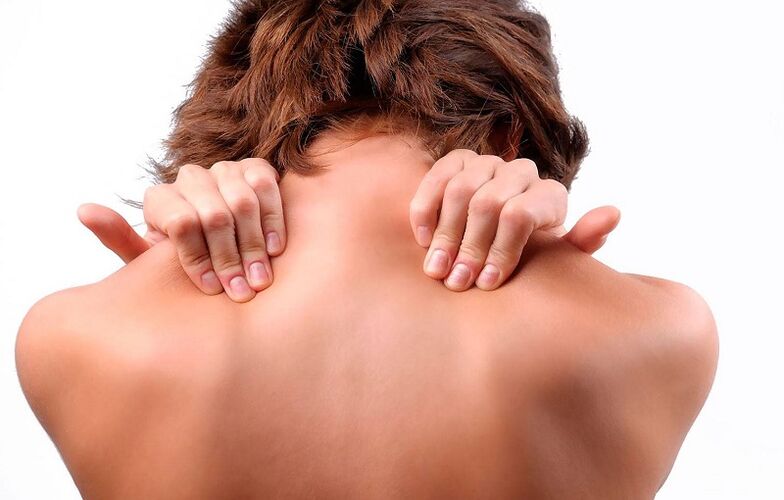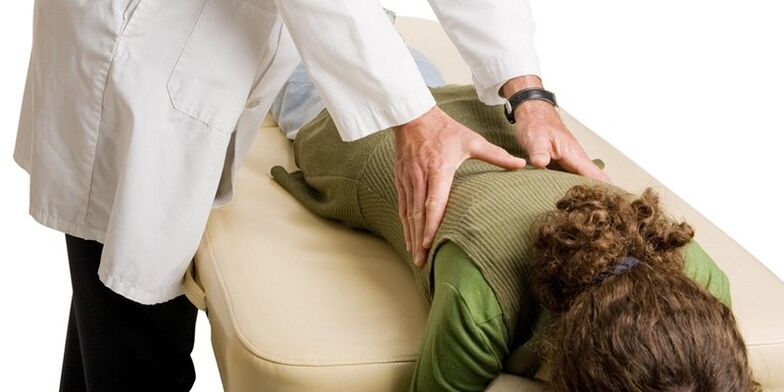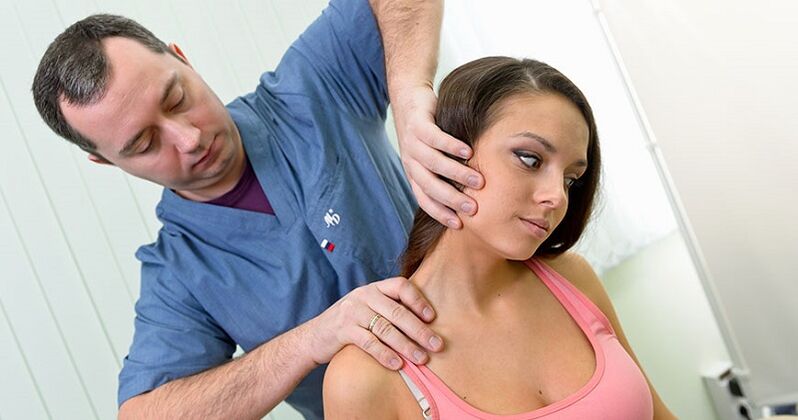
Osteochondrosis in medicine is usually called dystrophic changes in the intervertebral disc.This problem can appear in a person at any age.Intervertebral disc dysfunction can trigger the development of many unpleasant health problems.Therefore, it is necessary to immediately pay attention to the signs of osteochondrosis of the cervical spine, and then start treatment immediately.
General Description of Diseases
The cervical bones include 8 paired nerve nodes, as well as 7 vertebrae.Osteochondrosis of the cervical spine, as a rule, develops due to the fact that the intervertebral pulp degenerates into vitrified tissue.In parallel with this, pathological changes negatively affect the endings of nerve fibers, as well as important vessels.This pathology mainly affects the -8th and -7th vertebrae.

The signs of cervical osteochondrosis are easily confused with other pathologies.During this disease, attacks of headache are observed, and discomfort in the neck area is also felt.Signs of cervical osteochondrosis are also accompanied by dizziness, nausea, and blood pressure problems.In most cases, this disease is confused with blood vessel and heart disease.
It is important to note that often, against the background of pathology with the vertebrae, the patient begins to suddenly lose consciousness, feel the breath, and sometimes the tongue may become numb.Therefore, the signs of osteochondrosis of the cervical spine must, as they say, "Known by sight."
This unpleasant disease is diagnosed mainly in people over 30 years old.This is explained by the uniqueness of the location of the human skeleton, as well as the constant dynamic and statistical load.But it is worth paying attention to the fact that this disease has recently become younger, as a result of which signs of cervical osteochondrosis in women and men are observed even in adolescence.
Cause of disease
The development of this unpleasant disease is influenced by pathological and physiological processes.All of them are closely related to each other, and in medical practice, experts always consider them together.
As for physiological changes, they are caused by irreversible age-related processes that occur in the cartilage of the spine.These changes are localized in the central region of the intervertebral disc.Physiological signs of cervical osteochondrosis in women and men manifest themselves as pinching of the pulp by certain fibrous tissue.When the nerve endings are shocked, the patient begins to experience discomfort.
Pathological change is a process when the area of inflammation extends beyond the cartilage tissue zone.Pathological signs of osteochondrosis of the cervical spine in women and men can cause severe irritation in the area of nerve endings, as well as pinch blood vessels.Such changes can occur against the background of poor nutrition due to a sedentary lifestyle.In addition, pathological changes are often observed in adolescents and people in the middle age category.
It is important to note that the signs of osteochondrosis of the cervical spine in women and men in some cases disappear on their own or appear as short-term episodes.The human body has many protective and compensatory functions, which for some time can neutralize these pathological changes in the area of cartilage.

Causing factors
The following factors can cause the development of this unpleasant disease:
- Excess weight.
- Lack of constant physical activity, as well as sedentary work.
- Stress and nervous tension.
- The patient's body is often in an awkward position.
- Injuries to the back of the head and neck.
- Hypothermia.
It is also worth paying attention to the fact that signs of osteochondrosis of the cervical spine in men and women can appear due to congenital anomalies, as well as due to autoimmune diseases.
Main features
It should be noted that cervical osteochondrosis is sometimes not accompanied by pain in certain parts of the spine.Often this disease has an unclear clinical picture.The main symptoms of cervical spine osteochondrosis in men and women include dizziness, sudden changes in blood pressure, and migraines.However, it is necessary to highlight the symptoms that require hospitalization of the patient:
- Increasing headache, accompanied by deterioration of general health.
- Loss of mobility of the muscles of the shoulder girdle or face, numbness.
- Movement coordination.
- Loss of consciousness.
When considering the signs and symptoms of cervical osteochondrosis, you should pay attention to the fact that the pain often radiates to the limbs and shoulder blades.A distinctive feature of this is the pain syndrome, which is paroxysmal in nature.Basically, such pain occurs after waking up, during laughing, sudden movement, sneezing and coughing.
When answering the question about the symptoms of cervical osteochondrosis bothering the patient, you should pay attention to the fact that in the early stages of the disease, the pain quickly decreases, a crisis in the neck is often observed, the muscles become weaker, and the skin loses its sensitivity.
If there are pathological changes in the sixth vertebra, then pain may be felt in the thumb.And if the change affects the seventh vertebra, then pain appears in the middle finger.

Signs of osteochondrosis of the cervical and thoracic spine in women, as a rule, appear earlier than in the stronger half of humans.
Relationship with other diseases
The manifestation of signs of cervical osteochondrosis in men and women may be associated with other diseases.For example, experts have long established a relationship between blood pressure and cervical osteochondrosis.This unpleasant disease is characterized by sharp changes in blood pressure throughout the day, and persistent hypertension is not relevant for this disease.
Increased pressure during osteochondrosis can be accompanied by pain in the arms, chest, legs and noise in the head.Signs of osteochondrosis of the cervical and thoracic spine include decreased sensitivity of the skin in the collar area.Constant stress and prolonged exposure to uncomfortable positions can cause a jump in blood pressure.
Dizziness and cervical osteochondrosis occur due to severe pain, impaired cerebral circulation, and also due to the transmission of nerve signals.This may also occur due to problems with the vestibular system.Early signs of cervical osteochondrosis include non-systemic dizziness.In this case, the patient does not feel the spinning object, but there is severe nausea.It is very difficult for the patient to be in a standing position.
It is important to note that during dizziness, you should not only visit a neurologist, but also visit an ENT specialist so that this specialist can rule out the presence of pathological changes in the nasopharynx.
In most cases, osteochondrosis is accompanied by headaches.It occurs due to vascular spasm, increased intracranial pressure, and pinched nerve endings.Pain can manifest itself in different ways, whether it is dull or throbbing.
During osteochondrosis, headache attacks are similar to the sensations that occur with increased blood pressure, heart attacks, angina pectoris and strokes.
Panic attacks can occur during osteochondrosis against the background of existing disturbances in cerebral circulation.Patients experience physical discomfort and unreasonable fear.The duration of such an attack can range from a few minutes to 1 hour.Attacks may occur several times a day.In addition, panic attacks are accompanied by incessant tears, a feeling of heavy head, lethargy and apathy.If the patient has a severe attack, then it is necessary to regularly visit a psychiatrist and take sedatives.

Depression and fear occur with this disease against the background of constant pain, as well as forced changes in the usual lifestyle.
Diagnostic method
Most patients with osteochondrosis experience pain in the back of the head, in the arms and in the chest.The picture of this disease greatly complicates the initial diagnosis.In addition, uncontrolled use of painkillers prevents timely diagnosis.Patients who do not experience pain feel healthy.As a result, people seek medical help too late, when irreversible processes have already begun to develop in the tissues of the neck joints.
Diagnosis involves X-rays, after which it is possible to see R-Signs of osteochondrosis of the cervical spine.After the X-ray, the patient is prescribed a course of treatment.If the R-Signs of cervical osteochondrosis are unstable, the following symptoms will be observed:
- Angular deformity of the affected segment.
- Displacement of the vertebrae to the side, back or forward.
- If in 2 vertebrae there is a deviation on the vertical axis of more than 2 mm, then this indicates pathology.
It is worth paying attention to the fact that radiography is an ineffective diagnostic method, especially in the last stages of the development of osteochondrosis.
Also during diagnosis, the patient may be prescribed magnetic resonance imaging.MRI signs of osteochondrosis of the cervical spine help to establish a diagnosis for the patient.During the tomography, the specialist can see the bone structure, the herniated disc, as well as the direction of their development and size.If the MRI signs of cervical osteochondrosis are detected in time, the disease can be overcome quickly.
An ineffective solution from MRI is computed tomography.This procedure allows you to identify CT signs of osteochondrosis of the cervical spine.In addition, it is necessary to pay attention to the fact that computed tomography is much better for identifying the presence and size of the hernia.

Drug treatment
After the diagnosis, the specialist makes a diagnosis for the patient and also prescribes the appropriate treatment.Treatment with drugs is aimed at combating pain and inflammation.Drug treatment can restore normal mobility and circulation.The main groups of drugs in the treatment of this disease are as follows:
- Various analgesics in the form of injections and tablets to eliminate pain.
- Steroidal and nonsteroidal anti-inflammatory drugs.
- Chondroprotectors that restore cartilage tissue.
- To relax the muscles, muscle relaxants are prescribed.
- In addition, a vitamin complex is prescribed, which should contain all vitamins B, C, D, as well as ascorbic acid and retinol.
- For external use, you can use products in the form of ointments and gels that improve blood circulation, relieve pain and spasms, relieve pain and warm.
You should also pay attention to the fact that the vitamins contained in food products will not be enough to treat this unpleasant disease.Therefore, complex preparations can be used.
It is also recommended to take drugs that can improve cerebral circulation in case of existing cervical osteochondrosis.Taking such drugs is a mandatory component of the treatment of this disease.
Surgery
Surgical intervention for the treatment of osteochondrosis is used very rarely.However, the patient cannot do without surgery in cases where paralysis of the upper limbs is observed.Surgery is also required if the patient has cerebral edema.
Complementary therapy
Massage is recommended as an additional therapeutic measure.Experts also advise the use of manual therapy in the form of jerky translational movements.Very effective are: dose appeal, relaxation techniques and acupuncture.
Treatment at home
In combination with drug treatment, non-traditional recipes can also be used.Home therapy involves doing special exercises and techniques regularly, and using certain orthopedic devices.Traditional medicine recipes can be used as maintenance treatment.

To eliminate tension in the spine, reduce stress, and strengthen the neck muscles, you can use collar shants.The neck and head are fixed in a certain position.Thanks to this, you can overcome insomnia, as well as prevent the development of pathological changes.This collar must be worn for several hours before going to bed.In any case it should be used throughout the day.
Self-massage can relieve pain and stiffness.And during this procedure, it is recommended to additionally rub in the ointment, which can increase blood flow.Massage is done in a sitting position, the position should be comfortable and relaxed.Meanwhile, scrubbing and circular scrubbing is done.When carrying out such a procedure, not only the neck is affected, but also the shoulder girdle.
It is important to note that in the case of osteochondrosis of the cervical vertebrae, it is forbidden to use any type of heating, except sauna or steam bath.
Take a special bath
You can get rid of pain and inflammation with the help of a medicinal bath.Such a procedure is good for helping loosen the spine.Bathing should be done every day, and the treatment course should include 15 to 20 procedures.Bath recipe:
- Mix 300 g of mint and chamomile.Make the herb with 10 liters of boiling water.Let it steep for 2 hours, then strain.
- Take 40 g of lemon balm, the same amount of birch leaves and mint.Make the resulting composition with 12 liters of boiling water and let it steep for 2 hours.After this, strain the soup and pour it into the bath.
- To prepare an infusion based on sage, you need to take 300 g of this material and 5 liters of boiling water.Leave the medicinal solution for 2 hours, strain, after which you can use it.
For oral administration, you can use an infusion based on yarrow.Thanks to this, you can quickly get rid of inflammation, pain and spasms.To prepare the infusion, you need to take 230 ml of boiling water and 6 g of yarrow herb.Leave the liquor for one hour in a closed container.The finished product is taken three times a day, 15 ml.
A solution consisting of 1 liter of water and 15 g of sea salt is very effective in the fight against osteochondrosis.The salt solution must be brought to a boil, after which it must cool completely.Natural fabric is soaked in the resulting composition and then applied to the back of the neck.
Possible complications
If the diagnosis is made on time and the treatment is correct, then the disease should proceed without any complications.Otherwise, a rather severe pathological process can develop, which can cause disability in the future.Cervical osteochondrosis can be dangerous to human health.The main dangers include the following:
- Vertebral artery syndrome, in which organic and functional changes caused by blood circulation disorders in the brain are observed.
- Arrhythmia and high blood pressure.
- Muscle atrophy in the upper part, weakness, numbness.
- Hernia formation, protrusion.
- Neurological Disorders.
- Vs.

Conduct prevention
Preventive measures for osteochondrosis involve the simplest actions, which, if done regularly, can prevent the occurrence of serious problems with your health.Prevention is especially important for the elderly and those who spend too much time sitting.To prevent the development of osteochondrosis, it is necessary:
- Take a hot bath every day for at least 10 minutes.
- Periodically go to the sauna or bathhouse to eliminate neck tension and spasms.
- Sleep only on special mattresses and orthopedic pillows.
- When working sedentary, do at least 5 minutes of warm-up every hour.
Experts also recommend swimming, yoga, aerobic exercise, as well as special gymnastics that strengthen the neck muscles.
Patient Reviews
Reviews from people about the treatment of osteochondrosis of the cervical spine show that success is observed if medicines and traditional medicinal recipes are combined.Bathing with sea salt is very effective.But to achieve success in treatment, it is necessary to seek help from a specialist in time, immediately after detecting the first symptoms of the disease.

























